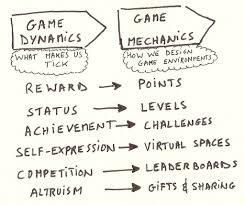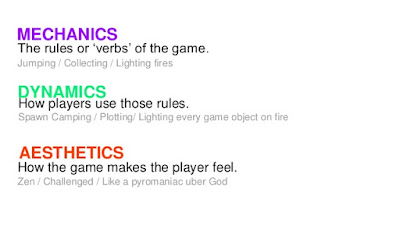The Role of Engagement and Presence in Online Courses
Engagement is related to motivation, in this instance the motivation to stay engaged in online courses. Maslow (1943, 1954, 1970) suggests that people are motivated to meet certain needs. When one fulfills a need, the person moves on to fulfill the next one. His earliest version of this hierarchy of needs included five motivational needs, often depicted within a pyramid (see Figure to the right). These first four needs are identified as deficit needs. If these deficit needs are not met, these needs make us uncomfortable, motivating us to sufficiently fulfill these needs. Referred to as growth needs, the last four needs constantly motivate us as they relate to our growth and development.
Maslow also arranged these needs in a hierarchy, indicating that we are primarily motivated by a need only if lower level needs have been met. This means that before cognitive or self-actualization needs can motivate us, we must address the basic deficit needs like physiological, security, belonging, and esteem. After students meet level 1basic needs and the safety needs of level 2, they next strive to meet the belonging needs of level 3. This level involves emotionally-based relationships in general, such as friendship, intimacy and having a supportive and communicative family. Students who lack these close relationships often exhibit low initiative and low levels of extraversion, impacting their ability and interest in interacting. Faculty can assist here by creating opportunities for students to interact with one another and with faculty, in a gamified environment, by using technology to foster community, one where students feel they belong. Faculty, then, can begin developing engagement by meeting students at their level 3 needs and continuing up through the levels.
Gamifying a class may be one way to help meet these needs.
A sense of community, also a part of engagement, has been significantly linked to perceived learning (Rovai, 2002; Shae, 2006). Garrison (2007) refers to community as presence, comprised of three types: social, cognitive, and teaching presence. Garrison, Anderson, and Archer (2000) developed a comprehensive Community of Inquiry framework (see Figure on the left) that suggests developing a community of learners is crucial to supporting higher level learning and discussion.
Research suggests this framework provides solutions for studying online learning (Garrison & Archer, 2003; Garrison, Cleveland-Innes, Koole, & Kappelman, 2006). Garrison et al. (2000) argue that any one of cognitive processing, social interactions, or teachers’ facilitation by itself is insufficient for fostering higher levels of critical thinking, but instead, these three elements have to co-exist and interact with one another to optimally facilitate learning (Bangert, 2008).
Aligning the integration of gamification into online courses using the MDA Framework and the Community of Inquiry Framework seems to be an appropriate place to begin.
Social presence
Students demonstrate social presence when they project themselves as real people within a community, establishing personal and purposeful relationships. A key point here is for students to recognize they are not here purely for social reasons, but to interact with common purpose for the sake of inquiry. Students need to feel secure to communicate openly and to create cohesion. Swan and Shih (2005) found that group cohesion is significantly related to social presence and perceived learning outcomes. Richardson and Swan (2003) go on to connect social presence with student and instructor satisfaction with and perceptions of a course. Social presence in online discussions has even been identified as a predictor of academic performance and can be used as early detection for students at risk of failing an online course (Joksimovic, Gasevic, Kovanovic, Riecke, & Hatala, 2015).Teaching presence
Teaching presence relates to the process of design, facilitation, and direction throughout the learning experience to achieve desired learning outcomes. Teaching presence should directly and indirectly facilitate social interactions and stimulate higher levels of cognitive processing. Interaction and discourse play a key role in higher-order learning but not without structure (design) and leadership (facilitation and direction). For example, without explicit guidance, students will likely engage primarily in serial monologues with brief responses rather than truly delving into the topic presented for discussion. This may require faculty to be more directive in their initial posts or in their responses, directing students to solve a particular problem or to require certain elements be present in student responses. Garrison and Archer (2003) suggest that teaching presence is a significant determinate of student satisfaction, perceived learning, and sense of community. Students relate timeliness of teacher direct comments to assignments as increasing their course satisfaction.Cognitive presence
Cognitive presence relates to the design and development of instructional materials, enabling students to construct and confirm meaning through related refection and discourse. Cognitive presence is the degree to which the learners can construct understanding through sustained reflection and communication (Rourke, Anderson, Garrison, & Archer, 2001). The phases of cognitive presence (Garrison, Anderson, & Archer, 2000), in increasing complexity, include (1) Triggering Event (that triggers issues for consideration); (2) Exploration (of issues, through brainstorming, questioning, and information exchange); (3) Integration (to construct meaning based on the ideas generated in Exploration); and (4) Resolution (to build consensus as learners confirm their understanding and apply new ideas to solve problems).
My step, then, is to explore how to integrate the MDA Framework into the Community of Inquiry.
References
Bangert, A. (2008, September). The influence of social presence and teaching presence on the quality of online critical inquiry. Journal of Computing in Higher Education, 20(1), 34-61.
Garrison, D. R. (2007). Online community of inquiry review: Social, cognitive, and teaching presence issues. Journal of Asynchronous Learning Networks, 11(1), 61-72.
Garrison, D. R. Anderson, T, & Archer, W. (2000). Critical inquiry in a text-based environment: Computer conferencing in higher education. The Internet and Higher Education 2(2–3), 87–105.
Garrison, D. R., & Archer, W. (2003). A community of inquiry framework for online learning. In M. Moore (Ed.), Handbook of distance education. New York: Erlbaum.
Garrison, D. R., Cleveland-Innes, M., Koole, M., & Kappelman, J. (2006). Revisting methodological issues in the analysis of transcripts: Negotiated coding and reliability. The Internet and Higher Education, 9(1), 1–8.
Joksimovic, S., Gasevic, D., Kovanovic, V., Riecke, B. E. & Hatala, M. (2015). Social presence in online discussions as a process predictor of academic performance. Journal of Computer Assisted Learning, 31, 638-654.
Maslow, A. H. (1943). A theory of human motivation. Psychological Review, 50(4), 370-96.
Maslow, A. H. (1954). Motivation and personality. New York: Harper and Row.
Maslow, A. H. (1970). Religions, values, and peak experiences. New York: Penguin.
Richardson, J. C., & Swan, K. (2003). Examining social presence in online courses in relation to students’ perceived learning and satisfaction. Journal of Asynchronous Learning Networks, 7(1), 68-83.
Rovai, A. P. (2002). Sense of community, perceived cognitive learning, and persistence in asynchronous learning networks. The Internet and Higher Education 5(4), 319–332.
Shea, P. (2006). A study of students’ sense of learning community in online environments. Journal of Asynchronous Learning Networks 10(10). Retrieved from >http://www.sloan-c.org/publications/jaln/v10n1/v10n1_4shea_member.asp
Swan, K. & Shih, L. F. (2005, October). On the nature and development of social presence in online course discussions. Journal of Asynchronous Learning Networks 9(3). Retrieved from http://www.sloan-c.org/publications/jaln/v9n3/pdf/

















